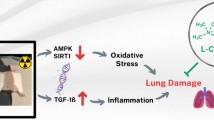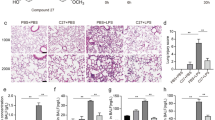Abstract
Doxorubicin (DOX), which is used to treat various cancers and hematological malignancies, has limited therapeutic application due to its toxicity in tissues and organs. These toxic effects occur through alterations in intracellular calcium regulation, elevated cell stress and oxidative damage, and increased apoptosis. Lercanidipine (LRD) is a long-acting antihypertensive calcium channel blocker with anti-inflammatory, anti-apoptotic, and antioxidant effects. The aim of this study was to investigate the effect of LRD on DOX-induced lung toxicity. Four groups (control, DOX, DOX + 0.5 LRD, and DOX + 2 LRD) totaling 32 rats were established. TNF-α levels in the lung tissues were detected by immunohistochemistry, and the tissues were subjected to histopathological examination. In determining oxidative stress, total antioxidant status (TAS) and total oxidative stress (TOS) were determined using spectrophotometry, and the oxidative stress index (OSI) value was calculated. The mRNA relative expression levels of the genes were evaluated by RT-qPCR. It was determined that inflammatory and oxidative stress markers and pro-apoptotic gene levels were increased and anti-apoptotic gene levels were decreased in the lung tissues of the DOX-administered group. In addition, histopathological changes were significantly increased. Although it was not statistically significant, inflammation, oxidative stress, and apoptosis were reduced, as were other histopathological indicators, in the group that received LRD (0.5 mg/kg). Inflammation, oxidative stress, and apoptosis were found to be statistically reduced and corroborated by histological findings in the group given LRD (2 mg/kg). In conclusion, it was determined that LRD had an ameliorative effect on DOX-induced lung toxicity in an experimental animal model.



Similar content being viewed by others
Data availability
The datasets generated during and/or analysed during the current study are available from the corresponding author on reasonable request.
References
Altindag O, Erel O, Soran N et al (2008) Total oxidative/anti-oxidative status and relation to bone mineral density in osteoporosis. Rheumatol Int 28:317–321
Benzer F, Kandemir FM, Kucukler S et al (2018) Chemoprotective effects of curcumin on doxorubicin-induced nephrotoxicity in wistar rats: by modulating inflammatory cytokines, apoptosis, oxidative stress and oxidative DNA damage. Arch Physiol Biochem 124:448–457
Borghi C (2005) Lercanidipine in hypertension. Vasc Health Risk Manag 1:173
Childs AC, Phaneuf SL, Dirks AJ et al (2002) Doxorubicin treatment in vivo causes cytochrome C release and cardiomyocyte apoptosis, as well as increased mitochondrial efficiency, superoxide dismutase activity, and Bcl-2: Bax ratio. Cancer Res 62:4592–4598
Gupta S, Sharma U, Jagannathan NR, Gupta YK (2017) Neuroprotective effect of lercanidipine in middle cerebral artery occlusion model of stroke in rats. Exp Neurol 288:25–37
Hu J, Wu Q, Wang Z et al (2019) Inhibition of CACNA1H attenuates doxorubicin-induced acute cardiotoxicity by affecting endoplasmic reticulum stress. Biomed Pharmacother 120:109475
İlhan İ, Halil A, Sevük MA et al (2022) Doksorubisin ile oluşturulan böbrek hasarında lerkanidipinin antioksidan ve antiapoptotik etkilerinin bcl-2/bax/sit c/cas-3 yolağı üzerinden araştırılması. SDÜ Tıp Fakültesi Derg 29:671–679
Injac R, Radic N, Govedarica B et al (2009) Acute doxorubicin pulmotoxicity in rats with malignant neoplasm is effectively treated with fullerenol C60 (OH) 24 through inhibition of oxidative stress. Pharmacol Reports 61:335–342
Karakuyu NF, Savran M, Candan IA et al (2023) Investigation of cardioprotective effect of lercanidipine on doxorubicin-induced cardiotoxicity. Naunyn Schmiedebergs Arch Pharmacol. https://doi.org/10.1007/s00210-023-02566-7
Martinez MLL, Lopes LF, Coelho EB et al (2006) Lercanidipine reduces matrix metalloproteinase-9 activity in patients with hypertension. J Cardiovasc Pharmacol 47:117–122
Mason RP (1999) Effects of calcium channel blockers on cellular apoptosis: implications for carcinogenic potential. Cancer 85:2093–2102
Olson RD, Mushlin PS, Brenner DE et al (1988) Doxorubicin cardiotoxicity may be caused by its metabolite, doxorubicinol. Proc Natl Acad Sci 85:3585–3589
Rashid S, Ali N, Nafees S et al (2013) Alleviation of doxorubicin-induced nephrotoxicity and hepatotoxicity by chrysin in Wistar rats. Toxicol Mech Methods 23:337–345
Robles NR, Ocon J, Gomez CF et al (2005) Lercanidipine in patients with chronic renal failure: the ZAFRA study. Ren Fail 27:73–80
Selvaraj N, Adhimoolam M, Perumal DK, Rajamohammed MA (2015) Neuroprotective effect of lercanidipine-A novel calcium channel blocker in Albino Mice. J Clin Diagnostic Res 9:FF01
Sonkusare S, Srinivasan K, Kaul C, Ramarao P (2005) Effect of donepezil and lercanidipine on memory impairment induced by intracerebroventricular streptozotocin in rats. Life Sci 77:1–14
Srdjenovic B, Milic-Torres V, Grujic N et al (2010) Antioxidant properties of fullerenol C60 (OH) 24 in rat kidneys, testes, and lungs treated with doxorubicin. Toxicol Mech Methods 20:298–305
Tangpong J, Cole MP, Sultana R et al (2006) Adriamycin-induced, TNF-α-mediated central nervous system toxicity. Neurobiol Dis 23:127–139
Tepebaşı MY, Büyükbayram Hİ, Özmen Ö et al (2023) Dexpanthenol ameliorates doxorubicin-induced lung injury by regulating endoplasmic reticulum stress and apoptosis. Naunyn Schmiedebergs Arch Pharmacol 396:1837–1845
Tsukamoto Y, Kiyasu J, Choi I et al (2020) Efficacy and safety of the modified EPOCH regimen (etoposide, vincristine, doxorubicin, carboplatin, and prednisolone) for adult T-cell leukemia/lymphoma: a multicenter retrospective study. Clin Lymphoma Myeloma Leuk 20:e445–e453
Viereckl M, Alojibaily N, Hydock D, Han Y (2020) The role of creatine supplementation in alleviating doxorubicin ınduced hepatotoxicity. FASEB J. https://doi.org/10.1096/fasebj.2020.34.s1.06416
Wang Z, Wang M, Liu J et al (2018) Inhibition of TRPA1 attenuates doxorubicin-induced acute cardiotoxicity by suppressing oxidative stress, the inflammatory response, and endoplasmic reticulum stress. Oxid Med Cell Longev. https://doi.org/10.1155/2018/5179468
Wang H, Dou S, Zhu J et al (2021) Regulatory effects of ghrelin on endoplasmic reticulum stress, oxidative stress, and autophagy: Therapeutic potential. Neuropeptides 85:102112
Warpe VS, Mali VR, Arulmozhi S et al (2015) Cardioprotective effect of ellagic acid on doxorubicin induced cardiotoxicity in wistar rats. J Acute Med 5:1–8
Xu Z-M, Li C-B, Liu Q-L et al (2018) Ginsenoside Rg1 prevents doxorubicin-induced cardiotoxicity through the inhibition of autophagy and endoplasmic reticulum stress in mice. Int J Mol Sci 19:3658
Yalçın A, Ahmet T, Aydın H et al (2020) Effects of Vitamin D on doxorubucin-induced lung injury and TRPM2 immunoreactivity in rats. J Surg Med 4:1236–1239
Yarmohammadi F, Rezaee R, Haye AW, Karimi G (2021) Endoplasmic reticulum stress in doxorubicin-induced cardiotoxicity may be therapeutically targeted by natural and chemical compounds: a review. Pharmacol Res 164:105383
Zawadzki A, Liu Q, Wang Y et al (2008) Verapamil inhibits L-type calcium channel mediated apoptosis in human colon cancer cells. Dis Colon Rectum 51:1696–1702
Zhang K (2010) Integration of ER stress, oxidative stress and the inflammatory response in health and disease. Int J Clin Exp Med 3:33
Author information
Authors and Affiliations
Contributions
All authors contributed at all stages of the study. All of the authors contributed to the design of the study, the collection of samples, the analysis, and the interpretation of data. MT and ES experiment planning, statistical analysis and genetic analysis, JS and AM histopathological and immunohistochemical analyses, SG and IH experimental animal applications.
Corresponding author
Ethics declarations
Conflict of interest
The authors have no relevant financial or non-financial interests to disclose. Dr. Tepebasi and the co-authors have no conflicts of interest to declare in association with this study.
Ethical approval
The animal experiments were approved by the local animal ethics committee of Suleyman Demirel University (no: 15.09.2022/06–81). The authors declare that the procedures were followed according to the regulations established by the Clinical Research and Ethics Committee and to the Helsinki Declaration of the World Medical Association updated in 2013.
Additional information
Publisher's Note
Springer Nature remains neutral with regard to jurisdictional claims in published maps and institutional affiliations.
Rights and permissions
Springer Nature or its licensor (e.g. a society or other partner) holds exclusive rights to this article under a publishing agreement with the author(s) or other rightsholder(s); author self-archiving of the accepted manuscript version of this article is solely governed by the terms of such publishing agreement and applicable law.
About this article
Cite this article
Tepebaşı, M.Y., Selli, J., Gül, S. et al. Lercanidipine alleviates doxorubicin-induced lung injury by regulating PERK/CHOP and Bax/Bcl 2/Cyt c pathways. Histochem Cell Biol 160, 361–368 (2023). https://doi.org/10.1007/s00418-023-02231-3
Accepted:
Published:
Issue Date:
DOI: https://doi.org/10.1007/s00418-023-02231-3




